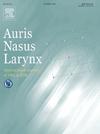Effectiveness of CI as an alternative to ABI for hearing loss in patients with vestibular schwannomas: A multicenter study in Japan
IF 1.6
4区 医学
Q2 OTORHINOLARYNGOLOGY
引用次数: 0
Abstract
Objective
NF2-related schwannomatosis (NF2) is characterized by bilateral vestibular schwannomas (VS), often causing severe damage to the bilateral auditory function. Auditory brainstem implantation (ABI) provides hearing-impaired patients with an opportunity to reacquire auditory sensation through electrical stimulation of auditory neurons in the cochlear nucleus. However, ABI is not covered by public health insurance in Japan, leading to a large difference in financial burden compared to cochlear implantation (CI). The aim of the present study was to demonstrate the effectiveness of CI as an alternative to ABI for hearing reacquisition in patients with profound hearing loss caused by VS.
Methods
To investigate the current situation of ABI and CI for hearing reconstruction in VS patients, we conducted a questionnaire survey of 102 facilities in Japan. Based on the responses to the questionnaire, a multicenter research group consisting of otolaryngologists and neurosurgeons was established. We collected detailed data on patients with VS who underwent ABI (n = 7, all NF2) and CI (n = 14 [nine NF2, and five non-NF2]).
Results
Some sense of hearing was obtained in all patients but one with CI indicating the efficacy of CI and ABI for profound hearing loss caused by VS. The mean hearing levels were 45.4 dB HL in the ABI patients and 32.7 dB HL in the CI patients, indicating that CI was effective as an alternative to ABI.
Conclusion
The results of the present study suggest the effectiveness of CI as an alternative to ABI for hearing reacquisition in patients with profound hearing loss caused by VS.
Level of evidence
4.
前庭分裂瘤患者用 CI 替代 ABI 治疗听力损失的效果:日本一项多中心研究。
目的:NF2相关分裂瘤病(NF2)的特征是双侧前庭分裂瘤(VS),通常会对双侧听觉功能造成严重损害。听觉脑干植入术(ABI)通过对耳蜗核中的听觉神经元进行电刺激,为听力受损患者提供了重新获得听觉感觉的机会。然而,在日本,ABI 不在公共医疗保险范围内,因此与人工耳蜗植入术(CI)相比,ABI 的经济负担差异很大。本研究的目的是证明人工耳蜗植入术作为人工耳蜗植入术的替代方案,对因 VS 引起的深度听力损失患者重新获得听力的有效性:方法:为了调查 ABI 和 CI 用于 VS 患者听力重建的现状,我们对日本的 102 家机构进行了问卷调查。根据问卷调查结果,我们成立了一个由耳鼻喉科医生和神经外科医生组成的多中心研究小组。我们收集了接受 ABI(7 人,均为 NF2)和 CI(14 人,其中 9 人为 NF2,5 人为非 NF2)治疗的 VS 患者的详细数据:结果:除一名接受 CI 的患者外,所有患者都获得了一定的听力,这表明 CI 和 ABI 对 VS 引起的深度听力损失具有疗效。ABI患者的平均听力水平为45.4 dB HL,CI患者的平均听力水平为32.7 dB HL,这表明CI可有效替代ABI:本研究结果表明,CI 可有效替代 ABI,帮助 VS 引起的深度听力损失患者重新获得听力:4:
本文章由计算机程序翻译,如有差异,请以英文原文为准。
求助全文
约1分钟内获得全文
求助全文
来源期刊

Auris Nasus Larynx
医学-耳鼻喉科学
CiteScore
3.40
自引率
5.90%
发文量
169
审稿时长
30 days
期刊介绍:
The international journal Auris Nasus Larynx provides the opportunity for rapid, carefully reviewed publications concerning the fundamental and clinical aspects of otorhinolaryngology and related fields. This includes otology, neurotology, bronchoesophagology, laryngology, rhinology, allergology, head and neck medicine and oncologic surgery, maxillofacial and plastic surgery, audiology, speech science.
Original papers, short communications and original case reports can be submitted. Reviews on recent developments are invited regularly and Letters to the Editor commenting on papers or any aspect of Auris Nasus Larynx are welcomed.
Founded in 1973 and previously published by the Society for Promotion of International Otorhinolaryngology, the journal is now the official English-language journal of the Oto-Rhino-Laryngological Society of Japan, Inc. The aim of its new international Editorial Board is to make Auris Nasus Larynx an international forum for high quality research and clinical sciences.
 求助内容:
求助内容: 应助结果提醒方式:
应助结果提醒方式:


